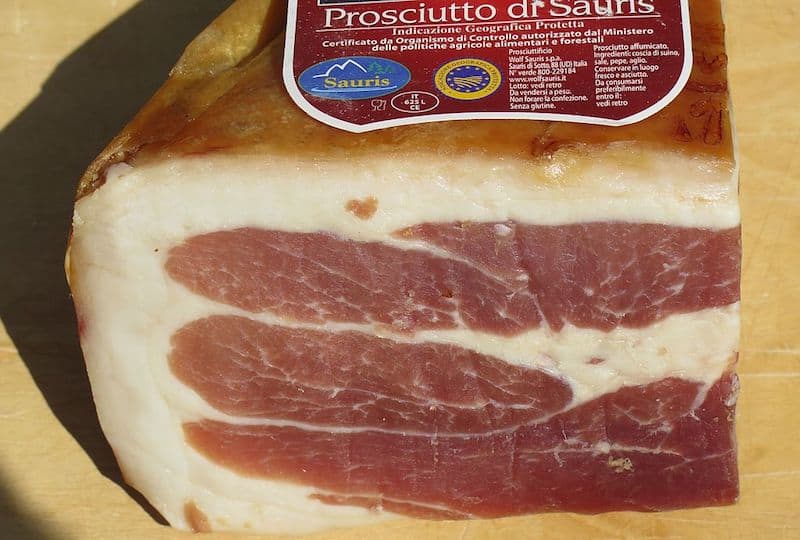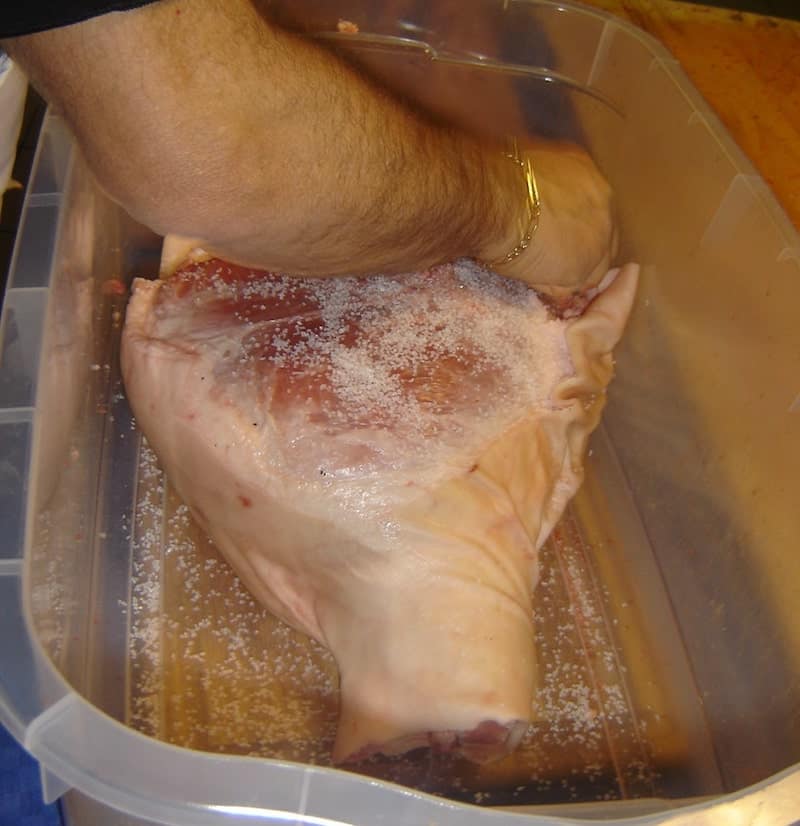White Mold on Prosciutto: Can You Still Eat It?
What’s up with that white mold on prosciutto? Is it safe to eat? What if my prosciutto has a lot of white mold? Should I throw away my prosciutto with white mold on it? These are all common questions among prosciutto lovers.
Prosciutto is made from a pig’s hind legs, and the natural skin and hair provide an ideal surface for molds to grow. Although mold is generally an enemy to all types of food, you’ll be pleased to learn that some species of mold are harmless.
In this article, I’ll provide more information about what causes white mold, how to spot it, and the implications it has for your prosciutto’s edibility and shelf life.
What is the White Mold on Prosciutto?
The Italians introduced prosciutto as a means of preserving meat before the advent of refrigeration.
Prosciutto is famous because it’s elegant, flavorful, and budget-friendly while also providing considerable cuisine versatility. It pairs exceptionally well with cheese, figs, grapes, honeydew melon, strawberry, and other cuisines.
White mold is a microscopic fungus that usually grows with a thread-like appearance and can be seen by the human eye as tiny specks or colonies of fuzziness. It’s one of the naturally occurring fungi found in air and water, including areas where food is produced or stored.
So, why does white mold grow on prosciutto?
Fungi generally thrive in dark places with low temperatures and humidity. And as it turns out, the preservation process used to produce prosciutto provides just that.
Prosciutto is produced by curing and air-drying thinly sliced or chopped pork with salt for approximately two weeks, then hanging it to drain off moisture for a few weeks or months.
The process of salting the meat draws water out from the cells and alters the protein structure much as pickling does. This leads to a rich meat flavor while inhibiting bacterial growth. In addition, curing helps preserve the meat, which would ordinarily spoil quickly due to its high fat content.
White mold and other microscopic fungi prefer to feed on meat – but hey, don’t get too worried. The fungus that grows on prosciutto is Penicillium nalgiovense, a harmless variety responsible for the white fluffiness we see on the surface.
The spores appear on the surface as soon as fermentation starts. Within a few days, the fungus covers the entire surface. It’s a natural way for the fungus to mark its territory and prevent other species of fungi from growing.
In summary, white mold on prosciutto is not known to be toxic. If anything, it helps keep other dangerous fungi away from your meat. However, ingesting it isn’t recommended. The good thing is that white mold washes off quickly and can be sliced off using a sharp knife.
Although white mold thrives by breaking down meat for consumption, this happens at a slow pace, so you shouldn’t be too worried about losing all your prosciutto.
Can You Eat Moldy Prosciutto?
It’s okay for prosciutto to have white fluffy mold on its surface. As previously explained, white mold is relatively harmless. It helps to keep out other bacteria that may not be too forgiving for your gut.
However, white mold makes prosciutto less appetizing in salads or as a garnish for different foods. Therefore, it is always best to wash it off before eating.
Be that as it may, you shouldn’t be too quick to wash and eat your prosciutto if it’s covered in non-white mold. Even though white mold is the predominant fungi species in cured meats, there are other varieties. Blue, black, or green mold, for example, could be toxic.
If you don’t want to take any chances, there are more reliable ways to determine whether you should eat moldy prosciutto. One of these is the smell of your meat.
Expertly cured prosciutto will have a very earthy, salty aroma. This is because the salinity of the meat is made dryer by curing it for long periods in salt and then introducing fresh air to cause more moisture loss. The moisture content in the final product is less than 20%.
When salted and dried naturally, as the prosciutto aging process requires, enzymes still survive and produce aromatic organic compounds from fats. This is what gives it that earthy smell.
A foul smell is definitely a red flag. Yes, the smell can be a little funky, but your prosciutto should never smell rancid.
A bad taste is another sure sign of unhealthy, probably rotting prosciutto. Well-cured prosciutto should be minimally salty, sweet, and tangy with a pleasant meaty aroma.
In addition, it should have subtle pepper notes that aren’t overwhelming. If the ham tastes too sweet or too salty, you’ll know that it’s not authentic prosciutto.
The true test of quality prosciutto – even when moldy – lies in its texture when sliced into paper-thin pieces. The lean white parts should be flexible and descend into slight curves under the weight of each slice.
If not, the prosciutto could be infected by bacteria that has rendered it rotten or too dry. The more marbled, fatty bits can get away with being a little stiffer, but they should retain that inviting umami flavor.
How Do You Remove Mold From Prosciutto?
Even if your prosciutto is covered entirely in white mold, you don’t have to throw it away.
First, use a sharp knife to cut off the moldy and dry edges.
Next, give it a light spritz of white wine vinegar or lemon juice to help remove unwanted flavor left behind by the mold. White wine vinegar is recommended since it has low acid content that won’t affect the meat.
Last but not least, pat down any remaining moisture with a paper towel.
If you’re dealing with a lot of mold, put your prosciutto in the freezer for an hour or two to kill any spores, and then use kitchen scissors to slice off the flesh that’s too contaminated to be eaten.
If desired, use the packaging as an indicator when cutting off moldy sections for disposal purposes. This will help you avoid incorporating the contaminated sections into the new, cleaner pieces of prosciutto.
If the mold covering is light, you could just wipe it off using vinegar.
Although prosciutto can be served raw, you should consider cooking it if it had a mold covering. This can be as simple as placing sliced pieces of prosciutto between two sheets of paper towel around sliced white bread and cooking on full power in the microwave for 30 seconds.
The high heat from the microwave will kill any toxins that may have penetrated the surface. Then use a cloth dampened with vinegar to wipe down the prosciutto surface on which mold appears.
Of course, you have to remember that prosciutto is a product that needs to be refrigerated at all times. Exposure to heat, high humidity, and light may lead to further mold growth.
In Summary
White mold on prosciutto can be a bit of an eyesore, but it’s a natural part of the aging process for cured meats.
However, it can reduce your prosciutto’s visual appeal and distort its taste. It’s also not good for you to eat, but there are ways to save your favorite snack if only the surface is affected. You can remove it with salt, water, lemon juice, or white wine vinegar.
If the white mold has penetrated too deep into the meat, no matter how much you try to cut away at it, there will be some contamination that can’t be removed. In this case, you may want to discard the entire piece of prosciutto.








